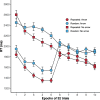Contextual cuing survives an interruption from an endogenous cue for attention
- PMID: 39388013
- PMCID: PMC11652569
- DOI: 10.3758/s13414-024-02966-8
Contextual cuing survives an interruption from an endogenous cue for attention
Abstract
Three experiments explored how the repetition of a visual search display guides search during contextual cuing under conditions in which the search process is interrupted by an instructional (endogenous) cue for attention. In Experiment 1, participants readily learned about repeated configurations of visual search, before being presented with an endogenous cue for attention towards the target on every trial. Participants used this cue to improve search times, but the repeated contexts continued to guide attention. Experiment 2 demonstrated that the presence of the endogenous cue did not impede the acquisition of contextual cuing. Experiment 3 confirmed the hypothesis that the contextual cuing effect relies largely on localized distractor contexts, following the guidance of attention. Together, the experiments point towards an interplay between two drivers of attention: after the initial guidance of attention, memory representations of the context continue to guide attention towards the target. This suggests that the early part of visual search is inconsequential for the development and maintenance of the contextual cuing effect, and that memory representations are flexibly deployed when the search procedure is dramatically interrupted.
Keywords: Attention; Contextual cuing; Endogenous cuing; Incidental learning; Visual search.
© 2024. The Author(s).
Conflict of interest statement
Declarations. Ethics Approval: Ethical approval was granted by the Department of Psychology Ethics Committee, Lancaster University, conforming to the British Psychological Society Code of Ethics and Conduct. Consent to Participate: All participants gave informed consent to participate in the study. All data was stored anonymously at the point of collection. Consent for Publication: All participants gave informed consent for their (anonymized) data to be used in publication.
Figures




Similar articles
-
Region segmentation and contextual cuing in visual search.Atten Percept Psychophys. 2009 Oct;71(7):1514-24. doi: 10.3758/APP.71.7.1514. Atten Percept Psychophys. 2009. PMID: 19801612
-
Pre-exposure of repeated search configurations facilitates subsequent contextual cuing of visual search.J Exp Psychol Learn Mem Cogn. 2015 Mar;41(2):348-62. doi: 10.1037/xlm0000033. Epub 2014 Jul 7. J Exp Psychol Learn Mem Cogn. 2015. PMID: 24999706
-
The nesting of search contexts within natural scenes: evidence from contextual cuing.J Exp Psychol Hum Percept Perform. 2010 Dec;36(6):1406-18. doi: 10.1037/a0019257. J Exp Psychol Hum Percept Perform. 2010. PMID: 20731525 Free PMC article.
-
Does contextual cuing guide the deployment of attention?J Exp Psychol Hum Percept Perform. 2007 Aug;33(4):816-28. doi: 10.1037/0096-1523.33.4.816. J Exp Psychol Hum Percept Perform. 2007. PMID: 17683230 Free PMC article.
-
Association between cue lead time and template-for-rejection effect.Atten Percept Psychophys. 2019 Aug;81(6):1880-1889. doi: 10.3758/s13414-019-01761-0. Atten Percept Psychophys. 2019. PMID: 31114955 Review.
References
-
- Beesley, T., Hanafi, G., Vadillo, M. A., Shanks, David. R., & Livesey, E. J. (2018). Overt attention in contextual cuing of visual search is driven by the attentional set, but not by the predictiveness of distractors. Journal of Experimental Psychology: Learning, Memory, and Cognition, 44(5), 707–721. 10.1037/xlm0000467 - DOI - PubMed
MeSH terms
LinkOut - more resources
Full Text Sources

